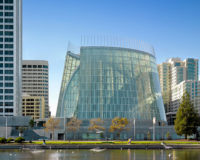Brooklyn
When CookFox Architects was going after a LEED Platinum rating for One Bryant Park, in New York (2009), its younger staff approached principals Rick Cook and Robert Fox. Granted, at 1,200 feet, the office tower would be the tallest green skyscraper in the world. But, Cook says, his employees asked, 'Why not bring sustainability to low-income and affordable housing?' The architects contacted Common Ground, a New York nonprofit social-services organization. Soon the firm was designing the Hegeman in Brooklyn, a LEED Silver building with 161 efficiency units for low-income and previously homeless men and women. The double do-good (social and environmental) project, completed in 2012 on Hegeman Avenue in the Brownsville neighborhood, not only bolsters Common Ground's desire to bring support services and affordable housing to long-ignored parts of the city, but now, says executive director Brenda Rosen, it acts as a talisman to Common Ground's Green Campaign.
While various governmental housing programs helped finance the $25 million construction cost ($320 a square foot) plus furnishings, Common Ground sought private funding for certain features and services'including a few green ones. The architects added energy-control devices to the 285-square-foot units; installed a 3,400-square-foot sedum roof and a photovoltaic system to harness sunlight energy for exterior lighting; and specified low-E and fritted glazing and solar shades.
On the more than half-acre site, formerly a parking lot, CookFox designed the six-story masonry-wall and concrete-plank structure to form an L that embraces an outdoor courtyard. A small garden for the larger community shoots off the northeast corner. To avoid relegating social-service activities and administration offices to windowless basement rooms, the architects placed the main level slightly below grade, where its spaces still have daylight and views of the courtyard. By partly submerging this level, the architects could also fit 77,000 square feet into a zoning area where the floor/area ratio of 3.44 would allow only 60,000 square feet to be built above ground.
In addition to green features, the design evokes the solidity of the early-20th-century brick rowhouses nearby, owing to the use of oxblood-red, molded (not extruded) brick, laid with a corbel pattern. In addition, deep recesses of the boxlike aluminum framing for the windows along the street underscore the depth of the load-bearing masonry walls and help shade the apartments inside.
The architecture exudes stability and permanence'core values of the program, where some residents pay $215 to $228 a month and others $600. The energy-efficient, clean, light-filled spaces, which include such amenities as a computer lab and a gym, seem to combine design, social services, and sustainability in a triple (not double) do-good success story.
Completion Date: June 2012
Gross square footage: 77,527 square feet
Total construction cost: $26.2 million
People
Owner:
Architect:
Personnel in architect's firm who should receive special credit:
Engineer(s):
Structural Engineer:
Consultant(s):
Other:
Consulting Soil Engineer
LEED Consultant
Energy Modeling and Commissioning Agent
Code Consultant
General contractor: Photographer(s): ©COOKFOX Architects (212-477-0287) Renderer(s): ©COOKFOX Architects (212-477-0287) |
Products
Structural system
Exterior cladding Metal/glass curtain wall: EFCO Moisture barrier: Henry Co. Air Block
Roofing Other: Green Roof Blocks
Windows
Glazing Skylights: Oldcastle BuildingEnvelope
Hardware Exit devices: Von Duprin Pulls: Inox
Interior finishes Demountable partitions: 3Form, Modernfold Paints and stains: Benjamin Moore Solid surfacing: Dupont Corian Floor and wall tile: Daltile, Nemo Tile Resilient flooring: Forbo, Monster’s Inc.
Lighting Exterior: Bega
Conveyance
Plumbing
Energy |







